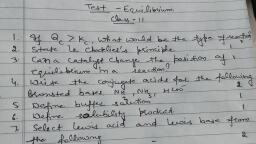Question 1 :
The partial pressure of {tex} \mathrm { CH } _ { 3 } \mathrm { OH } ( \mathrm { g } ) , \mathrm { CO } ( \mathrm { g } ) {/tex} and {tex} \mathrm { H } _ { 2 } ( \mathrm { g } ) {/tex} in equilibrium mixture for the reaction, {tex} \mathrm { CO } ( \mathrm { g } ) + 2 \mathrm { H } _ { 2 } ( \mathrm { g } ) \rightleftharpoons \mathrm { CH } _ { 3 } \mathrm { OH } ( \mathrm { g } ) {/tex} are {tex} 2.0,1.0 {/tex} and {tex} 0.1{/tex} atm respectively at {tex} 427 ^ { \circ } \mathrm { C } {/tex}. The value of {tex} \mathrm { K } _ { \mathrm { p } } {/tex} for the decomposition of {tex} \mathrm { CH } _ { 3 } \mathrm { OH } {/tex} to {tex} \mathrm { CO } {/tex} and {tex} \mathrm { H } _ { 2 } {/tex} is
Question 2 :
Some inert gas is added at constant volume to the following reaction at equilibrium {tex} \mathrm { NH } _ { 4 } \mathrm { HS } ( \mathrm { s } ) \rightleftharpoons \mathrm {NH_3(g)} + \mathrm { H_2S (g)} {/tex}. Predict the effect of adding the inert gas:
Question 3 :
Equal volumes of three acid solutions of {tex} \mathrm {pH}{/tex} {tex} 3,4 {/tex} and {tex}5{/tex} are mixed in a vessel. What will be the {tex} \mathrm { H } ^ { + } {/tex} ion concentration in the mixture?
Question 4 :
In a saturated solution of the sparingly soluble strong electrolyte {tex}\mathrm{AgIO} {tex} _ { 3 } {/tex} (molecular mass {tex} = 283 {/tex} ) the equilibrium which sets is {tex} \mathrm { AgIO } _ { 3 } ( s ) \rightleftharpoons \mathrm { Ag } ^ { + } ( a q ) + \mathrm { IO } _ { 3 } ^ { - } ( a q ) . {/tex} If the solubility product constant {tex} \mathrm{K _ { s p }} {/tex} of {tex} \mathrm { Ag } \mathrm { IO } _ { 3 } {/tex} at a given temperature is {tex} 1.0 \times 10 ^ { - 8 } , {/tex} what is the mass of {tex} \mathrm { AgIO } _ { 3 } {/tex} contained in {tex} 100 \mathrm { ml } {/tex} of its saturated solution?
Question 5 :
The equilibrium constant for a reaction is {tex} \mathrm { K } , {/tex} and the reaction quotient is {tex} \mathrm { Q } {/tex}. For a particular reaction mixture, the ratio {tex} \frac { \mathrm { K } } { \mathrm { Q } } {/tex} is {tex} 0.33 . {/tex} This means that :
Question 6 :
Using the Gibb's energy change, {tex} \Delta G ^ { \circ } = + 63.3 \mathrm { kJ } , {/tex} for the following reaction,<br>{tex} \quad \mathrm { Ag } _ { 2 } \mathrm { CO } _ { 3 ( \mathrm { s } ) } \rightleftharpoons 2 \mathrm { Ag } ^ { + }(aq) + \mathrm { CO } _ { 3 } ^ { 2 - }(aq){/tex}<br> the {tex} K _ { \mathrm { sp } } {/tex} of {tex} \mathrm { Ag } _ { 2 } \mathrm { CO } _ { 3 ( s ) } {/tex} in water at {tex} 25 ^ { \circ } \mathrm { C } {/tex} is {tex} \left( R = 8.314\ \mathrm { J\ K } ^ { - 1 } \mathrm {\ mol } ^ { - 1 } \right) {/tex}<br>
Question 7 :
The {tex} \mathrm{K _ { s p }} {/tex} for {tex} \mathrm { Cr } ( \mathrm { OH } ) _ { 3 } {/tex} is {tex} 1.6 \times 10 ^ { - 30 } . {/tex} The solubility of this compound in water is:
Question 8 :
The rapid change of pH near the stoichiometric point of an acid-base titration is the basis of indicator detection. pH of the solution is related to ratio of the concentrations of the conjugate acid {tex} ( \mathrm { HIn } ) {/tex} and base {tex}\mathrm {(In^{-})}{/tex} forms of the indicator by the expression
Question 9 :
The standard Gibbs energy change at {tex} 300 \mathrm { K } {/tex} for the reaction {tex} 2 \mathrm { A } \rightleftharpoons \mathrm { B } + \mathrm { C } {/tex} is {tex} 2494.2 \mathrm { J } {/tex}. At a given time, the composition of the reaction mixture is {tex} [ \mathrm { A } ] = \frac { 1 } { 2 } , [ \mathrm { B } ] = 2 {/tex} and {tex} [ \mathrm { C } ] = \frac { 1 } { 2 } . {/tex} The reaction proceeds in the: {tex} [ \mathrm { R } = 8.314 \mathrm { J } / \mathrm { K } / \mathrm { mol } , e = 2.718 ] {/tex}
Question 10 :
{tex} \mathrm { K } _ { \mathrm { c } } {/tex} for {tex} \mathrm { PCl } _ { 5 } ( \mathrm { g } ) \rightleftharpoons \mathrm { PCl } _ { 3 } ( \mathrm { g } ) + \mathrm { Cl } _ { 2 } ( \mathrm { g } ) {/tex} is {tex}0.04{/tex} at {tex}250 ^ { \circ } \mathrm { C } {/tex}. How many moles of {tex} \mathrm { PCl } _ { 5 } {/tex} must be added to a {tex} 3 \mathrm { L } {/tex} flask to obtain a {tex} \mathrm { Cl } _ { 2 } {/tex} concentration of {tex} 0.15 \mathrm { M } {/tex}
Question 11 :
Solid {tex} \mathrm {AgNO_3} {/tex}, is slowly added to a solution containing each of {tex}0.01{/tex} {tex}\mathrm{M}{/tex} {tex} \mathrm {NaCl} {/tex} and {tex}0.001{/tex} {tex}\mathrm{M}{/tex} {tex} \mathrm {NaBr} {/tex}. What will be the concentration of {tex}\mathrm{Cl}^-{/tex} ions in solution when {tex}\mathrm {AgBr} {/tex} will just start to precipitate? <img style='object-fit:contain' src='https://storage.googleapis.com/teachmint/question_assets/NEET/5ee0d97bc8d68358b1cddd3a' class="uploaded-image" />
Question 12 :
The pH value of a {tex} \mathrm {10\ M } {/tex} solution of {tex} \mathrm { HCl } {/tex} is
Question 13 :
In qualitative analysis, the metals of group {tex} \mathrm {I}{/tex} can be separated from other ions by precipitating them as chloride salts. A solution initially contains {tex} \mathrm { Ag } ^ { + } {/tex} and {tex} \mathrm { Pb } ^ { 2 + } {/tex} at a concentration of {tex} \mathrm { 0.10\ M } {/tex} . Aqueous {tex} \mathrm { HCl} {/tex} is added to this solution until the {tex}\mathrm {Cl^{-}}{/tex} concentration is {tex} \mathrm {0.10\ M } {/tex} . What will the concentrations of {tex} \mathrm { Ag } ^ { + } {/tex} and {tex} \mathrm { Pb } ^ { 2 + } {/tex} be at equilibrium?<br>{tex} \left( K _ { s p } \text { for } \mathrm { AgCl } = 1.8 \times 10 ^ { - 10 } , K _ { s p } \text { for } \mathrm { PbCl } _ { 2 } \right. {/tex} {tex} \left. = 1.7 \times 10 ^ { - 5 } \right) {/tex}<br>
Question 15 :
The value of equilibrium constant of the reaction {tex} \mathrm { HI } _ { ( g ) } \rightleftharpoons \frac { 1 } { 2 } \mathrm { H } _ { 2 ( g ) } + \frac { 1 } { 2 } \mathrm { I } _ { 2 ( g ) } {/tex} is {tex} 8.0 . {/tex} The equilibrium constant of the reaction {tex} \mathrm { H } _ { 2 ( g ) } + \mathrm { I } _ { 2 ( g ) } \rightleftharpoons 2 \mathrm { HI } _ { ( g ) } {/tex} will be<br>
Question 16 :
Which of the following statements is correct for a reversible process in a state of equilibrium?
Question 17 :
Zirconium phosphate {tex} \left[ \mathrm { Zr } _ { 3 } \left( \mathrm { PO } _ { 4 } \right) _ { 4 } \right] {/tex} dissociates into three zirconium cations of charge {tex} + 4 {/tex} and four phosphate anions of charge {tex} - 3 . {/tex} If molar solubility of zirconium phosphate is denoted by {tex} \mathrm { S } {/tex} and its solubility product by {tex} \mathrm { K } _ { \mathrm { sp } } {/tex} then which of the following relationship between {tex} \mathrm { S } {/tex} and {tex} \mathrm { K } _ { \mathrm { sp } } {/tex} is correct?
Question 18 :
The values of for the reactions, <br>{tex} { X \rightleftharpoons Y + Z \ \ \ \ \ \ \ ......\mathrm{(i)}} {/tex}<br>{tex}{ A \rightleftharpoons 2 B\ \ \ \ \ \ \ \ \ \ \ \ \ .......\mathrm{(ii)} } {/tex}<br>are in the ratio {tex} 9 : 1 . {/tex} If degree of dissociation of {tex} X {/tex} and {tex} A {/tex} be equal, then total pressure at equilibrium {tex}\mathrm {(i)}{/tex} and {tex}\mathrm {(ii)}{/tex} are in the ratio<br>
Question 19 :
A physician wishes to prepare a buffer solution at {tex}\mathrm {pH} = 3.85{/tex} that efficiently resists changes in {tex}\mathrm {pH}{/tex} yet contains only small concentration of the buffering agents. Which of the following weak acids together with its sodium salt would be best to use?
Question 20 :
Calculate the {tex}\mathrm{pH}{/tex} of {tex}0.5\mathrm{\ M}{/tex} aqueous solution of {tex} \mathrm { NaCN } , {/tex} the {tex} \mathrm { pK } _ { \mathrm { b } } {/tex} of {tex} \mathrm { CN } ^ { - } {/tex} is {tex}4.70{/tex}
Question 21 :
The solubility product of {tex} \mathrm {AgI} {/tex} at {tex} 25 ^ { \circ } \mathrm { C } {/tex} is {tex}\mathrm { 1.0 \times 10 ^ { - 16 } { mol } ^ { 2 }} \mathrm { L } ^ { - 2 } {/tex} . The solubility of {tex} \mathrm {AgI} {/tex} in {tex} 10 ^ { - 4 } \mathrm { N } {/tex} solution of {tex} \mathrm { KI } {/tex} at {tex} 25 ^ { \circ } \mathrm { C } {/tex} is approximately (in {tex} \mathrm {mol \ L^{-1}} {/tex})
Question 22 :
What is the pH of the resulting solution when equal volumes of {tex} \mathrm {0.1 \ M\ NaOH } {/tex} and {tex} 0.01\ \mathrm { M\ HCl } {/tex} are mixed?
Question 23 :
A weak acid, {tex} \mathrm { H A} , {/tex} has a {tex} K _ { a } {/tex} of {tex} 1.00 \times 10 ^ { - 5 } {/tex} . If {tex}\mathrm {0.100}{/tex} mol of this acid is dissolved in one litre of water, the percentage of acid dissociated at equilibrium is closest to
Question 24 :
Consider the expression {tex} \Delta \mathrm { G } = - \mathrm { RT } \ln \mathrm { K } _ { \mathrm { p } } + \mathrm { RTInQ } _ { \mathrm { p } } {/tex} and indicate the correct statement at equilibrium
Question 25 :
On the basis of Le Chatelier's principle, predict which of the following conditions would be unfavourable for the formation of {tex} \mathrm { SO } _ { 3 } ? {/tex} Given that<br>{tex} 2 \mathrm { SO } _ { 2 } + \mathrm { O } _ { 2 } \rightleftharpoons 2 \mathrm { SO } _ { 3 } ; \Delta \mathrm { H } = - 42 \mathrm { kcal } {/tex}<br>
Question 26 :
The value of {tex}\mathrm K _ { p } {/tex} for the equilibrium reaction {tex} \mathrm { N } _ { 2 } \mathrm { O } _ { 4 } ( g ) \rightleftharpoons 2 \mathrm { NO } _ { 2 } ( g ) {/tex} is {tex} 2 . {/tex} The percentage dissociation of {tex} \mathrm { N } _ { 2 } \mathrm { O } _ { 4 } ( g ) {/tex} at a pressure of {tex} 0.5 \mathrm { atm } {/tex} is
Question 27 :
A solution is saturated with respect to {tex} \mathrm { SrCO } _ { 3 } {/tex} and {tex} \mathrm { SrF } _ { 2 } {/tex}. The {tex} \left[ \mathrm { CO } _ { 3 } ^ { 2 - } \right] {/tex} was found to be {tex} 1.2 \times 10 ^ { - 3 } \mathrm { M } {/tex}. The concentration of {tex} \mathrm { F } ^ { - } {/tex} in the solution would be <br>Given, {tex} \mathrm { K } _ { \mathrm { sp } } {/tex} of {tex} \mathrm { Sr } \mathrm { CO } _ { 3 } = 7.0 \times 10 ^ { - 10 } \mathrm { M } ^ { 2 } {/tex}, {tex} \mathrm { K } _ { \mathrm { sp } } {/tex} of {tex} \mathrm { SrF } _ { 2 } = 7.9 \times 10 ^ { - 10 } \mathrm { M } ^ { 3 } {/tex}
Question 28 :
In a buffer solution containing equal concentration of {tex} B ^ { - } {/tex} and {tex} \mathrm {H}B , {/tex} the {tex} K _ { b } {/tex} for {tex} B ^ { - } {/tex} is {tex} 10 ^ { - 10 } {/tex} . The pH of buffer solution is
Question 29 :
For the reversible reaction, {tex} \mathrm { N } _ { 2 ( g ) } + 3 \mathrm { H } _ { 2 ( g ) } \rightleftharpoons 2 \mathrm { NH } _ { 3 ( g ) } + {/tex} heat . The equilibrium shifts in forward direction<br>
Question 30 :
Solubility product of silver bromide is {tex} 5.0 \times 10 ^ { - 13 } {/tex}. The quantity of potassium bromide (molar mass taken as {tex} \left( 120\ \mathrm { g } \mathrm { mol } ^ { - 1 } \right) {/tex} to be added to {tex}1{/tex} litre of {tex}\mathrm{0.05\ M}{/tex} solution of silver nitrate to start the precipitation of {tex}\mathrm{AgBr}{/tex} is
Question 31 :
The dissociation of a gas {tex} \mathrm { AB } _ { 2 } {/tex} at equilibrium can be represented as:<br>{tex} 2 \mathrm { AB } _ { 2 } ( g ) \rightleftharpoons 2 \mathrm { AB } ( g ) + \mathrm { B } _ { 2 } ( g ) {/tex}<br>The degree of dissociation is ' {tex} x {/tex} ' and is small compared to 1. The expression relating the degree of dissociation ( {tex} x {/tex} ) with equilibrium constant {tex} \mathrm { K } _ { \mathrm { p } } {/tex} and total pressure {tex} \mathrm { P } {/tex} is:
Question 32 :
For preparing a buffer solution of {tex}\mathrm{pH}\ 6{/tex} by mixing sodium acetate and acetic acid, the ratio of the concentration of salt and acid should be {tex} \left( \mathrm { K } _ { \mathrm { a } } = 10 ^ { - 5 } \right) {/tex}
Question 33 :
What is the decreasing order of basic strengths of {tex} \mathrm { OH } ^ { - } , \mathrm { NH } _ { 2 } ^ { - } , \mathrm { H } - \mathrm { C } \equiv \mathrm { C } ^ { - } {/tex} and {tex} \mathrm { CH } _ { 3 } - \mathrm { CH } _ { 2 } ^ { - } {/tex}
Question 34 :
A solution of {tex} \mathrm { NH } _ { 4 } \mathrm { Cl } {/tex} and {tex} \mathrm { NH } _ { 3 } {/tex} has {tex}\mathrm{pH}{/tex} {tex} = 8.0 . {/tex} Which of the following hydroxides may be precipitated when this solution is mixed with equal volume of {tex} 0.2 \mathrm { M } {/tex} of metal ion.
Question 35 :
Ionisation constant of {tex} \mathrm { CH } _ { 3 } \mathrm { COOH } {/tex} is {tex} 1.7 \times 10 ^ { - 5 } {/tex} and concentration of {tex} \mathrm { H } ^ { + } {/tex} ions is {tex} 3.4 \times 10 ^ { - 4 } {/tex} . Then find out initial concentration of {tex} \mathrm { CH } _ { 3 } \mathrm { COOH } {/tex} molecules.
Question 36 :
Given the reaction between 2 gases represented by {tex} A _ { 2 } {/tex} and {tex} B _ { 2 } {/tex} to give the compound {tex} A B _ { ( g ) } {/tex} .<br>{tex}A_{2(g)} + B_{2(g)} \rightleftharpoons 2AB_{(g)} {/tex}<br>At equilibrium, the concentration of {tex} A _ { 2 } = 3.0 \times 10 ^ { - 3 } \mathrm { M } , {/tex} of {tex} B _ { 2 } = 4.2 \times 10 ^ { - 3 } \mathrm { M } , {/tex} of {tex} A B = 2.8 \times 10 ^ { - 3 } \mathrm { M } {/tex}. If the reaction takes place in a sealed vessel at {tex}\mathrm {527^\circ C}{/tex}, then the value if {tex}K_C{/tex} will be
Question 37 :
A solution of {tex} 0.1 \mathrm { M } \ \mathrm { Na } \mathrm { Z } {/tex} has {tex} \mathrm { pH } = 8.90 . {/tex} The {tex} \mathrm { K } _ { \mathrm { a } } {/tex} of {tex} \mathrm { HZ } {/tex} is
Question 38 :
The concentration of {tex} \left[ \mathrm { H } ^ { + } \right] {/tex} and concentration of {tex} \left[ \mathrm { OH } ^ { - } \right] {/tex} of a {tex} \mathrm {0.1}{/tex} aqueous solution of {tex} \mathrm 2 \% {/tex} ionised weak acid is [ionic product of water = {tex} \left. 1 \times 10 ^ { - 14 } \right] {/tex}
Question 39 :
{tex} M Y {/tex} and {tex} N Y _ { 3 } , {/tex} two nearly insoluble salts, have the same {tex} K _ { \mathrm { sp } } {/tex} values of {tex} 6.2 \times 10 ^ { - 13 } {/tex} at room temperature. Which statement would be true in regard to {tex} M Y {/tex} and {tex} N Y _ { 3 } ? {/tex}
Question 40 :
The following reaction is performed at {tex} 298 \mathrm { K } {/tex}.<br>{tex} 2 \mathrm { NO } ( \mathrm { g } ) + \mathrm { O } _ { 2 } ( \mathrm { g } ) \rightleftharpoons 2 \mathrm { NO } _ { 2 } ( \mathrm { g }){/tex}<br>The standard free energy of formation of {tex} \mathrm { NO } ( \mathrm { g } ) {/tex} is {tex} 86.6 \mathrm { kJ }/ \mathrm {mol } {/tex} at {tex} 298 \mathrm { K } {/tex}. What is the standard free energy of formation of {tex} \mathrm { NO } _ { 2 } ( \mathrm { g } ) {/tex} at {tex} 298 \mathrm { K } ? \left( \mathrm{K _ { p }} = 1.6 \times 10 ^ { 12 } \right) {/tex}



















































